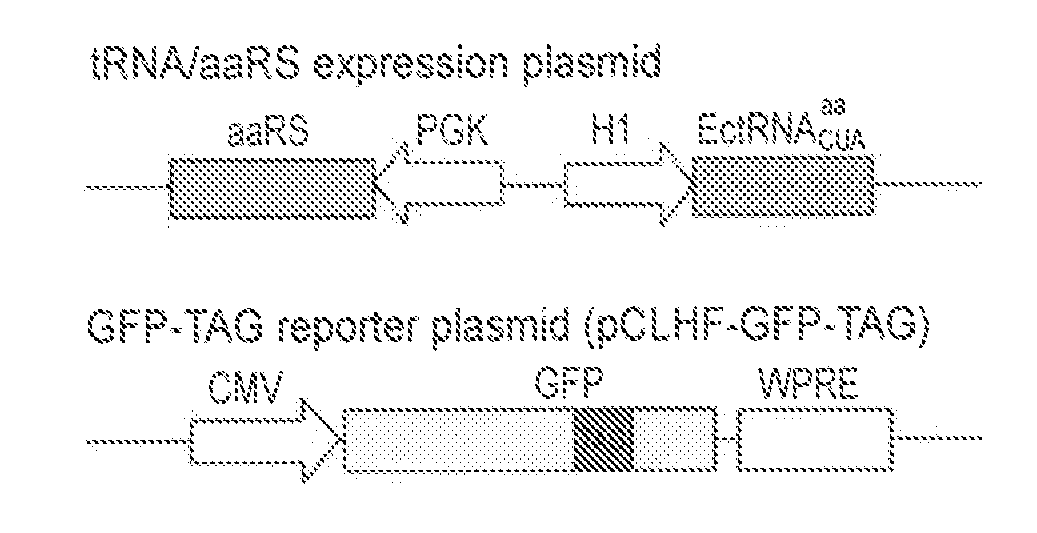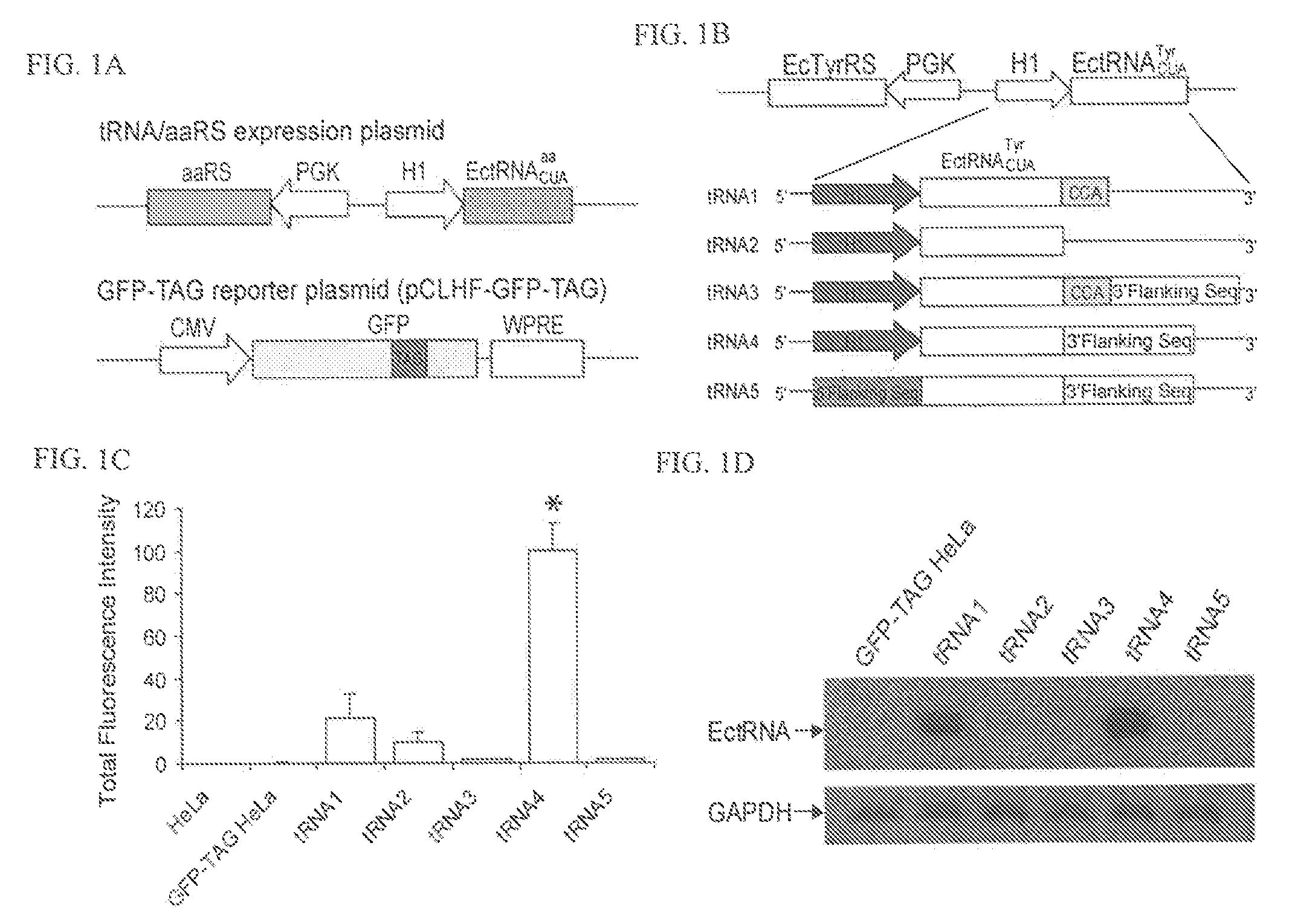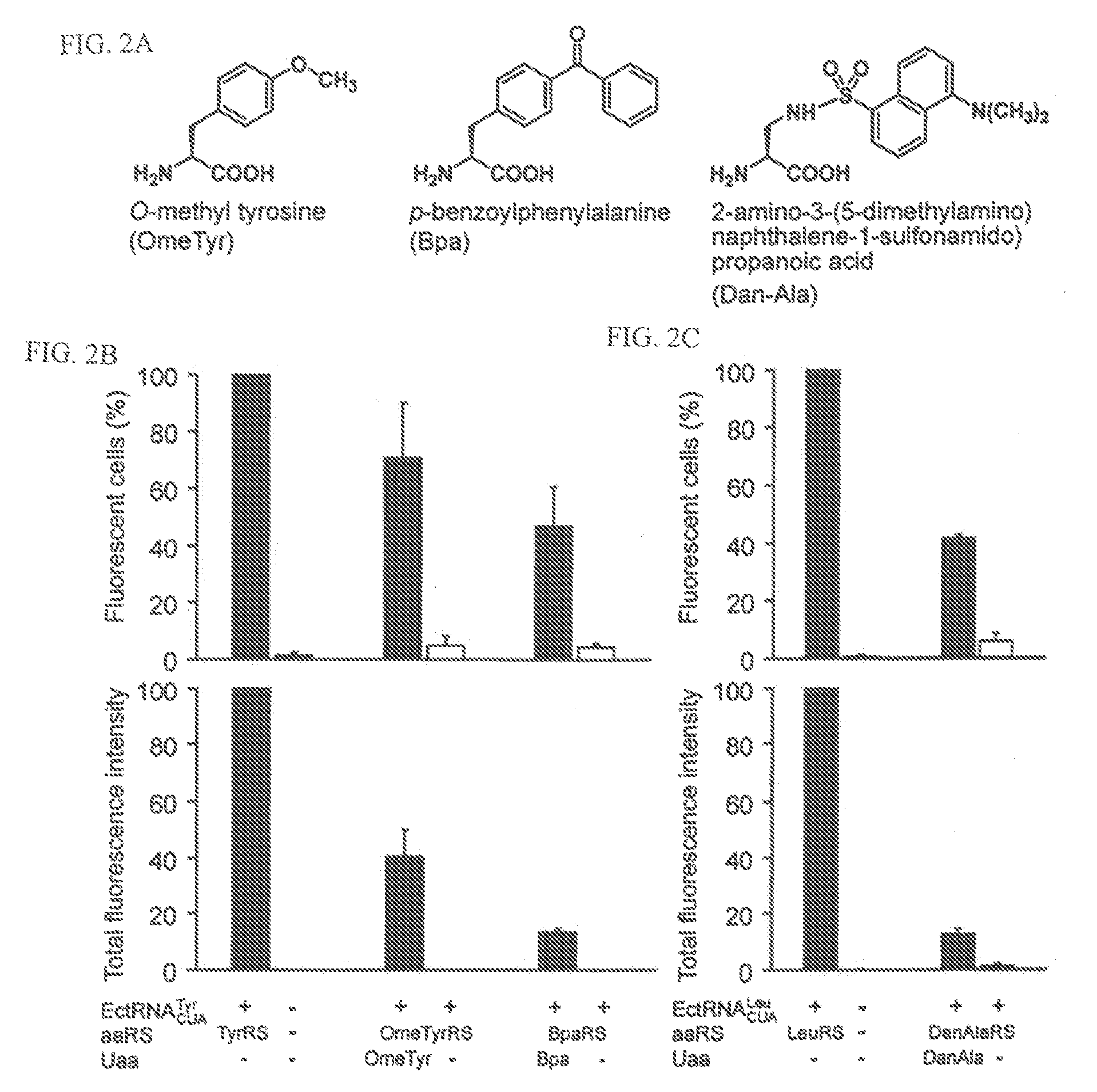METHODS OF GENETICALLY ENCODING UNNATURAL AMINO ACIDS IN EUKARYOTIC CELLS USING ORTHOGONAL tRNA/SYNTHETASE PAIRS
a technology of orthogonal trna and synthetase, which is applied in the preparation of hybrid cells, biochemistry apparatus and processes, microorganisms, etc., can solve the problems of inability to collect data for a long time, low yield of mutant proteins, and inability to study, so as to increase the efficiency of incorporation of unnatural amino acids
- Summary
- Abstract
- Description
- Claims
- Application Information
AI Technical Summary
Benefits of technology
Problems solved by technology
Method used
Image
Examples
example 1
Materials and Methods
[0220]This Example describes materials and methods that were used in performing Examples 2-4. Although particular methods are described, one of skill in the art will understand that other, similar methods also can be used.
Chemicals
[0221]OmeTyr and Bpa were purchased from Chem-Impex. DanAla was synthesized using a procedure previously described (see, for instance, Summerer et al. (2006) Proc. Natl. Acad. Sci. U.S.A. 103, 9785-9789). All other chemicals were purchased from Sigma-Aldrich.
Constructs
[0222]All constructs were assembled by standard cloning methods and confirmed by DNA sequencing. Plasmid pCLHF is a derivative of pCLNCX (Imgenex), and contains the hygromycin resistance gene instead of the neomycin resistance gene. The amber stop codon TAG was introduced into the enhanced GFP (EGFP) gene at position 182 through site-directed mutagenesis. The woodchuck hepatitis virus posttranscriptional regulatory element (WPRE; Zufferey et al., (1999) J. Virol. 73, 2886...
example 2
Expression of Orthogonal tRNAs in Eukaryotic Cells
[0231]This Example demonstrates efficient expression of prokaryotic orthogonal tRNAs in mammalian cells. Although particular methods of expressing prokaryotic orthogonal tRNAs in mammalian cells are described, one of skill in the art will appreciate that similar methods can be used to express prokaryotic tRNAs in other eukaryotic cells using other pol III promoters.
[0232]One way to generate an orthogonal tRNA / synthetase pair is to import a tRNA / synthetase pair from species in a different kingdom because the cross aminoacylation between different species is often low. However, expression of functional E. coli tRNAs in mammalian cells is challenging. E. coli and mammalian cells differ significantly in tRNA transcription and processing. E. coli tRNAs are transcribed by the sole RNA polymerase through promoters upstream of the tRNA structural gene. The transcription of mammalian tRNA genes, however, depends principally on promoter elemen...
example 3
Use of Unnatural Amino Acid (UAA) Synthetase in Eukaryotes
[0243]This Example describes the use of an UAA specific synthetase in mammalian cells. Although particular methods of using orthogonal synthetases in mammalian cells are described, one of skill in the art will appreciate that similar methods can be used to express and use orthogonal synthetases in other eukaryotic cells.
[0244]Synthetases specific for a variety of UAAs have been evolved in E. coli and in yeast from large mutant synthetase libraries containing of >109 members (Wang & Schultz, (2004) Angew. Chem. Int. Ed. Engl. 44, 34-66). Similar strategies cannot be practically employed in mammalian cells and neurons because the transfection efficiencies of these cells are lower by several orders of magnitude than that of E. coli and yeast.
[0245]To demonstrate the feasibility of transferring the mutant synthetases evolved in yeast to mammalian cells, the E. coli TyrRS gene in the tRNA / aaRS expression plasmid (FIG. 1A) was repl...
PUM
| Property | Measurement | Unit |
|---|---|---|
| nucleic acid | aaaaa | aaaaa |
| chemical diversity | aaaaa | aaaaa |
| fluorescence- | aaaaa | aaaaa |
Abstract
Description
Claims
Application Information
 Login to View More
Login to View More - R&D
- Intellectual Property
- Life Sciences
- Materials
- Tech Scout
- Unparalleled Data Quality
- Higher Quality Content
- 60% Fewer Hallucinations
Browse by: Latest US Patents, China's latest patents, Technical Efficacy Thesaurus, Application Domain, Technology Topic, Popular Technical Reports.
© 2025 PatSnap. All rights reserved.Legal|Privacy policy|Modern Slavery Act Transparency Statement|Sitemap|About US| Contact US: help@patsnap.com



